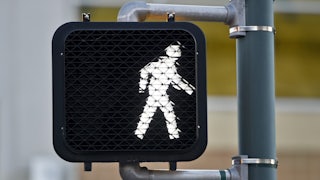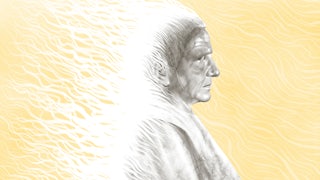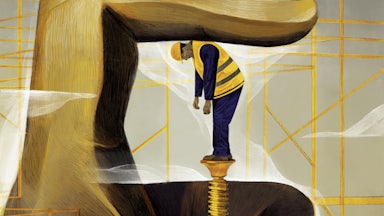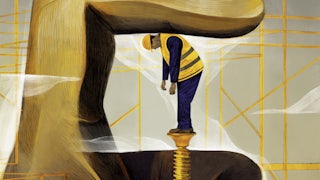The restaurant as we know it was invented in Paris around the late 1700s. Foreign visitors called the city’s restaurants the “most peculiar” and “most remarkable” things. At a traditional inn or tavern, you ate what was served, at a communal table, around set mealtimes. But now, at a restaurant, you got to sit at your own table, at any old time, and order what you wanted to eat. The ability to choose your food also required another newfangled technology: a menu, to organize and inform you of your options.
Judging by reports from the time, the whole experience, especially of menus, could be bewildering. In 1803, for example, the English journalist Francis Blagdon published a travelogue about Paris, and he had to pause to explain what a menu even was. Imagine “a printed sheet of double folio, of the size of an English newspaper,” Blagdon told his readers. He then reproduced in full the menu of the fashionable Parisian restaurant run by Antoine Beauvilliers. It took up nine pages of Blagdon’s book, and he grumped that it was hard to tell what each dish was based on its “pompous, big-sounding name.” “It will require half an hour at least,” Blagdon advised, to pore over “this important catalogue.”
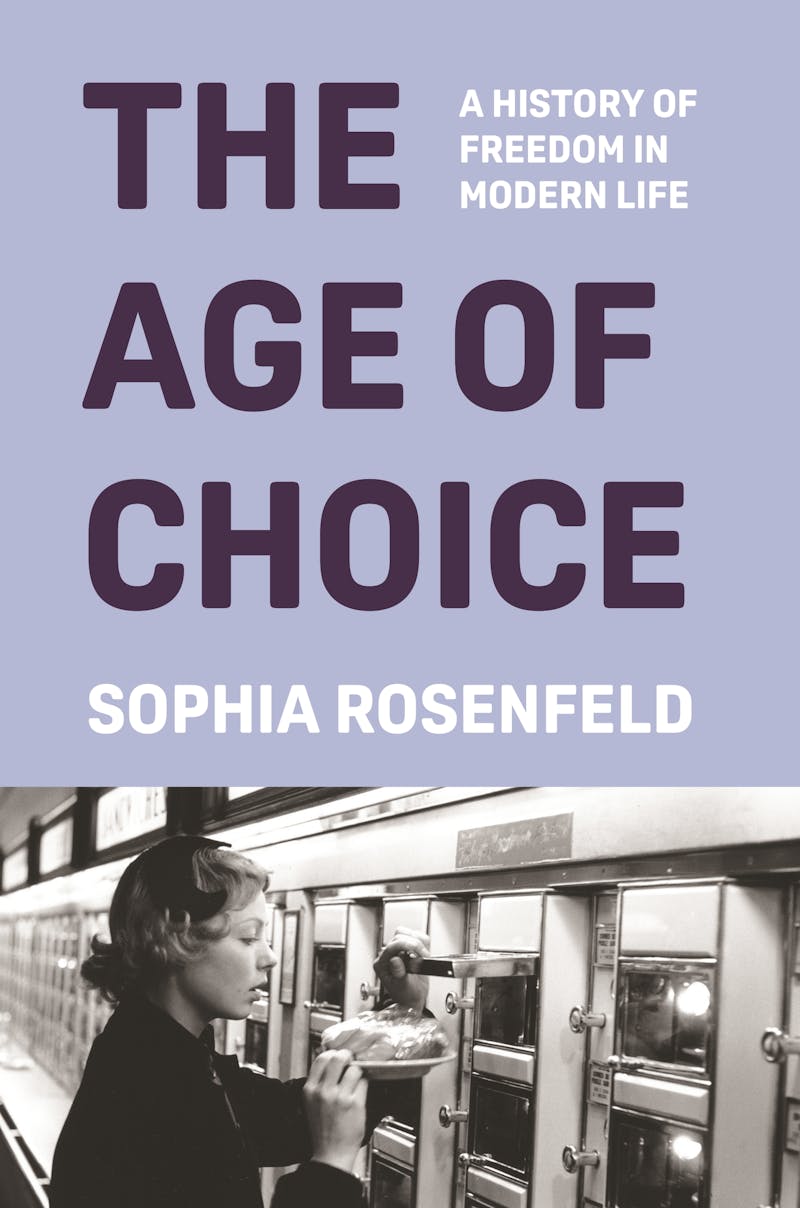
Most people today, of course, don’t take half an hour to read a menu in excruciating detail. (Though they might complain about needing a QR code just to find it.) But Blagdon’s mix of wonder and annoyance at menus in 1803 suggests that, in the late eighteenth and early nineteenth centuries, people had to learn—or, rather, they had to be trained by enterprising restaurateurs—how to choose what they wanted from a menu of possibilities.
For the historian Sophia Rosenfeld, that small act of choosing—and that now utterly mundane technology for choosing, the menu—mark a surprisingly important moment in the evolution of modern ideas about freedom. We have embraced “the logic of the menu,” Rosenfeld writes in her perceptive and nimble new book, The Age of Choice: A History of Freedom in Modern Life. We expect to make choices about everything. We still fight intense cultural and political battles about what choices will be available and who gets to choose. The left tends to emphasize individual choice on social issues, as with the pro-choice movement, while the right tends to portray unregulated economic choice within free markets as the essence of liberty. But across those divides, Rosenfeld says, we largely agree that “having choices and making choices” are what count “as being, indeed feeling, free.”
It was not always so. Rosenfeld tracks an expanding ideology of what she calls “freedom-as-choice” from the late 1600s to today. And she argues that if we recognize that our contemporary “choice idolatry” is just one recent way to understand what it means to be free, we might be able to begin imagining new, less “limited” and “hollow” ideas of freedom.
Rosenfeld has a knack for zooming in on seemingly ordinary objects, interpreting them in unexpected ways, and using them to reframe our picture of the modern world. Words like “daring” and “audacious” rightly come up when other historians describe her work. In The Age of Choice, she assembles an eclectic mix of everyday objects like menus alongside social practices like ballroom dancing, political debates about issues like voting rights, and high philosophy, reading those varied texts to piece together the story of the ideology of choice.
Focusing on the Atlantic world, Rosenfeld examines the idea and the act of choosing in five arenas: choice in goods (think menus), choice in ideas (freedom of speech and religion), choice in romantic partners (rather than arranged marriages), choice in politics (especially voting by secret ballot), and the sciences of choice (picture the advertising gurus on Mad Men). As these different forms of choice expanded over the last four centuries, Rosenfeld contends, society has increasingly taken it for granted that choice is the path—and the only path—to freedom.
Commerce and consumer culture have deeply shaped these notions of freedom and choice, as much as or more than political argument has. Like eating at restaurants, the practice of shopping in stores emerged in the 1700s. Modern shopping arose, in part, from colonial conquest, globalized trade, and the resulting material abundance as new goods flowed into imperial metropoles like London. The “calico craze” of the late 1600s, for instance, brought patterned cotton cloth from India to Europe and sparked buying across social classes. To market such fabrics to consumers, merchants increasingly used “fixed location shops,” rather than older venues like fairgrounds or peddlers’ carts.
Shops were a powerful new technology for consumption. Much as restaurateurs offered menus to diners, shopkeepers displayed fabrics on hooks and shelves to show shoppers what they could choose. And as glassmaking techniques improved, enabling ever wider and clearer panes, Rosenfeld explains, more and more goods appeared behind “glazed glass store windows” for shoppers to browse as they passed in the street. In 1786, the German writer Sophie von La Roche captured the rush of window-shopping in London: “Behind great glass windows absolutely everything one can think of is neatly, attractively displayed and in such abundance of choice as almost to make one greedy.” For some, there were too many choices, and how-to guides for shopping proliferated, like the 1785 book The Tea Purchaser’s Guide; or, The Lady and Gentleman’s Tea Table and Useful Companion, in the Knowledge and Choice of Teas or the 1824 book Guide dans la choix des étrennes (Guide in the Choice of Gifts).
Around the same time, people in Europe and its North American colonies started to think they should also get to choose their own beliefs. After the Protestant Reformation and the Wars of Religion, European states began legalizing religious dissent. Rulers allowed this religious pluralism for “strategic reasons,” Rosenfeld writes, “to maintain internal peace” and “increase their own might at the expense” of the church. But despite those grubby motives, law and philosophy embraced a soaring rhetoric of religious choice. John Locke argued, “No man can so far abandon the care of his own salvation as blindly to leave it to the choice of any other,” while the French Revolutionary Constitution of Year III (1795) declared, “No man can be hindered from exercising the worship he has chosen.”
Choice in belief expanded far beyond religion, too. As states relaxed censorship laws, Rosenfeld explains, readers could encounter new and contradictory ideas in a rapidly multiplying range of ways, from “books and pamphlets and newsletters” to “schools, learned societies, taverns, coffeehouses, tent revivals, clubs, lending libraries, bookshops, masonic lodges, general stores.” Book reviews were founded to help people choose—Monthly Review in 1749 and Critical Review in 1756—and individual readers used commonplace books to jot down ideas they found in other texts. Locke even wrote a how-to guide, A New Method of Making Common-Place-Books, which publishers reprinted as a preface in blank commonplace books into the 1800s.
Commonplacing was an ancient practice, but Rosenfeld argues that it underwent a crucial change in the eighteenth and nineteenth centuries. Commonplace books used to be tools to record the great wisdom of the past. But now they became “a tool for the construction and expression of one’s own personal take on the world.” Just as you might share an end-of-year Spotify playlist today, in a commonplace book you defined yourself by choosing your ideas. And that helped transform choice into a value-neutral act: It wasn’t about choosing the right things, it was about personal preference. “The right choice turned into the preferred one,” Rosenfeld says. The only shared moral value became the act of choosing itself. Consumer culture, especially on the internet, still teaches people to think that way today.
All that choosing also undermined traditional authorities, including the church, state censors, local customs, and the family. The age of choice produced significant social anxieties as a result. That was especially true with regard to women: Rosenfeld tracks how patriarchal commentators criticized the supposedly frivolous choices of women as shoppers, as readers, and as believers. Indeed, Rosenfeld shows, the misogynistic stereotype of women as ditzy shoppers dates to this period—novels increasingly featured scenes of women shopping, often greedily or indecisively, while the Scottish doctor William Alexander wrote in 1779 that the new activity of “shopping, as it is called,” was a “fashionable female amusement” in which women browsed through stores, “thoughtless of their folly.” Such anxieties about bad choices, in turn, generated social mechanisms to guide and even control choice, leaving choosers with what Rosenfeld dubs “bounded choice.”
Take dance cards. By the 1800s, the ideal of companionate marriage—marrying for love, rather than purely for social or financial advantage—had gained traction. This development, combined with increasing socioeconomic mobility, created more choices (and a greater risk of making bad choices) when it came to romantic partners. As Jane Austen’s novels dramatize, social dances, from elite balls to popular dance halls, were one way to navigate romantic choice. And dance cards helped organize the options. Women wore dance cards on their wrist or skirt, and men would ask for a specific dance on the night’s program. If a woman accepted, she wrote the man’s name by the relevant dance on her card, composing a kind of romantic menu for the evening. Dance cards were thus “a choice-facilitating fashion accessory,” Rosenfeld writes. They “must have seemed a small way to try to control the potential chaos” of the widening world of romance.
Social dances and romance could also serve a more liberating purpose. Rosenfeld is a historian of the Enlightenment, and her book can feel a bit thinner on the late nineteenth and twentieth centuries, particularly in the United States. George Chauncey’s 1994 study Gay New York showed how drag balls in the early 1900s, especially in Harlem, forged forms of often cross-racial freedom for gay and transgender people. Dylan C. Penningroth’s Before the Movement, published in 2023, similarly argues that after the U.S. Civil War, African Americans saw the legal right to decide on romantic partners and family membership as “one of the quintessential exercises of civil rights.” Loving v. Virginia, which struck down laws banning interracial marriage, was a major victory in the civil rights movement. And while we’re thinking about the social spaces for making choices, Traci Parker’s 2019 Department Stores and the Black Freedom Movement recounts how shopping became a key battleground for civil rights—the sit-ins, after all, were about desegregating lunch counters and department stores.
That brings us to politics. Rosenfeld traces the rise of modern ideas about political choice not only to voting, but to voting by secret ballot. Voting used to be a raucous public affair. On election day, voters would “publicly state” their choice before “family members, neighbors, and employers or customers.” In 1776, though, a pamphlet tellingly titled “Take Your Choice!” made the case for secret ballots. And by the late 1800s—despite fervent opposition from thinkers like John Stuart Mill—voting occurred in private booths, using menu-like ballots that listed the options. The turn to secret ballots, Rosenfeld writes, spurred “popular attention to political life as something which required choices on the part of ordinary people.”
The idea of freedom as political choice was the battlefield on which the long fight for women’s suffrage played out. Rosenfeld narrates that struggle in compelling detail, showing how feminist activists leveraged the rhetoric of choice to win the vote. Susan Gay of the Women’s Liberal Federation, for example, argued in 1892 that having the right to vote would allow a woman to be “a human being in its full sense, free of choice.” And in 1909, the Women’s Social and Political Union, a militant pro-suffrage group co-founded by Emmeline Pankhurst, held a Women’s Exhibition in London that included both voting booths and shopping stalls, seeking to dramatize how women’s wise choices in the realm of shopping could extend to wise political choices, too.
Voting rights, of course, remained deeply racialized. During Reconstruction in the United States, white supremacist mobs attacked Black voters and burned ballots. Voting rights activists in the South were similarly assaulted in the 1960s, perhaps most famously at the Edmund Pettus Bridge on Bloody Sunday in 1965. Civil rights activists and their foes had very different ideas of what freedom means. But Rosenfeld persuasively argues that, despite deep divisions about who should have the right to vote in the late nineteenth and twentieth centuries, the core concept of what voting is and why it matters came to rest largely on the idea that voting is the expression of individual preference through private choice in the voting booth.
By the mid-twentieth century, all this voting, shopping, freedom of conscience, and romantic choice coalesced into the ideology of “freedom-as-choice.” The United States defended that ideology, often coercively, in the Cold War. The twentieth century also saw the rise of sciences of choice, from psychology to advertising to economics: all ways of understanding, or in some cases manipulating, how people choose. And the law enshrined choice as a “new morality.” The Universal Declaration of Human Rights protected the right to “freely chosen” political representatives, while the International Covenant on Civil and Political Rights, in notably gendered terms, guaranteed “everyone” the “freedom to have or to adopt a religion or belief of his choice” and “the right to freedom of expression” via “media of his choice.” In the late twentieth century, Rosenfeld contends, “the moral doctrine of human rights” was closely associated “with unlimited and unimpeded freedom of choice.”
Despite the universalist aspirations of human rights, however, we still fight fierce political battles about choice. In the 1960s, feminist groups like the National Organization for Women embraced the concept of “freedom of choice” to define their goals. Indeed, Rosenfeld argues, “in liberal second-wave feminism, choice was turned into a form of secular salvation.” Then, after Roe v. Wade, feminists defended abortion rights in the rhetoric of choice: the right to choose, the pro-choice movement, the slogan “my body, my choice.” The conservative backlash to Roe was consequently framed as a claim that pro-life values trump individual choice—or, in sometimes explicitly misogynistic ways, as a claim that women lack the right to make choices. The degree to which we contest the scope of choice reveals an underlying agreement that choice is what matters.
But as Rosenfeld notes in the epilogue of The Age of Choice, some thinkers and activists, especially Black feminists, have long argued that choice is a limited way to imagine liberation. The Black feminist legal scholar Dorothy Roberts, for example, describes how “black feminists at a 1994 pro-choice conference” developed the idea of “reproductive justice,” which demands not just individual choice about whether to have children, but also the socioeconomic resources to raise children “in safe, healthy, and supportive environments.” All choices occur “within a social context,” Roberts writes, “including inequalities of wealth and power.” Those inequalities determine who can afford to raise a child, or who can actually access abortion care. Roberts thus calls for a shift from a politics that emphasizes “choice” to one that emphasizes “social justice” by combating the “intersecting race, gender, and class oppressions” that limit people’s freedom.
Simply having the right to choose, in other words—especially consumer choice in the economic arena—doesn’t offer real self-determination without the financial resources and social and political power to make meaningful decisions about one’s life. All the consumer options on Amazon don’t make people free. Social structures and hierarchies set the boundaries for choice. For that reason, civil rights and anti-colonial activists across the twentieth century developed rich critiques of oppression and alternative visions of freedom that focused on socioeconomic equality, not just choice. Freedom, such activists insisted, depends on things like the power to form a labor union, the right to health care and housing, and the end of environmental racism. Those “freedom dreams,” in Robin D.G. Kelley’s resonant phrase, are worth remembering today.
Rosenfeld concludes by hoping that our narrow “attachment to choice” can expand to envision “new kinds of politics,” new forms of freedom. But we don’t necessarily need to invent entirely new ideas. Many past activists in the labor, civil rights, and feminist movements saw freedom as something that exists not only in individual choice, but in equality, solidarity, and the collective project of transforming the social, political, legal, and economic systems that subordinate some to others. As the Combahee River Collective put it: “If Black women were free, it would mean that everyone else would have to be free since our freedom would necessitate the destruction of all the systems of oppression.” The challenge today, in the face of both ever-proliferating consumer choices and intensifying plutocracy, is to make the idea of equality—economic and political—central to a widely shared understanding of freedom.


